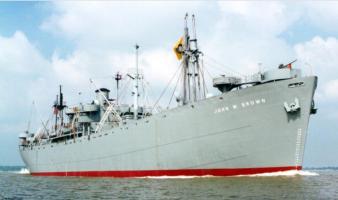 As we have previously posted, the restored Liberty ship, John W. Brown, was at risk of becoming homeless when its five-year agreement for berthing at Rukert Terminals’ Pier C in Canton, Maryland expired last September. Now, if all goes well, the historic ship may find a new home at the site of the Bethlehem Fairfield Shipyard in Baltimore, where she was built in 1942.
As we have previously posted, the restored Liberty ship, John W. Brown, was at risk of becoming homeless when its five-year agreement for berthing at Rukert Terminals’ Pier C in Canton, Maryland expired last September. Now, if all goes well, the historic ship may find a new home at the site of the Bethlehem Fairfield Shipyard in Baltimore, where she was built in 1942.
In a press release from earlier in the week:
Project Liberty Ship Inc., owner and operator of the World War II museum ship SS JOHN W. BROWN, and Maritime Applied Physics Corp. (MAPC) today announced an $18 million plan to revitalize a portion of the former Bethlehem Steel Fairfield Shipyard and provide a home base for the ship’s education and cruise activities as well as support for MAPC’s growing shipbuilding and maritime technology operations.
The proposal would utilize federal and state funding, augmented by corporate and individual donations, to rebuild a fitting-out pier at the former yard in South Baltimore. The pier would be owned and administered by a non-profit entity.
That is the plan, at least. As Michael Barnes of Project Liberty Ship Inc., the all-volunteer group that owns and operates the John W. Brown, told the Baltimore Sun, no funding is yet in place to support the project. The group hopes that federal and state grants will cover some 60% to 70% of the cost, with the rest coming from corporate and private donations.
Barnes estimated the cost of the project at $10 million to $11 million for installation of a floating pier, which would have to be augmented to be strong enough to hold the John W. Brown, or $18 million to replace the structure with a “heavy-duty commercial pier” that could accommodate both the Brown and MAPC’s operations.
The proposal is still at the conceptual design stage. Once a final design is chosen, permitting, demolition and construction must take place. The permitting process involves the U.S. Army Corp of Engineers, the Maryland Port Administration, Maryland Department of Natural Resources, Maryland Historical Trust, U.S. Fish and Wildlife, U.S. Coast Guard, and others, but Barnes is optimistic that things will go smoothly because the project calls for replacing an existing pier, and because no dredging is required.
With an estimated completion goal of about two years, Project Liberty Ship is still working on a solution for interim docking.
John W. Brown is one of two remaining operational World War II Liberty Ships out of 2,710 built in an emergency shipbuilding program to carry troops and cargo. More than 350 were mass-produced at the Bethlehem-Fairfield shipyard.

Its too bad this ship cant find work to pay her own way.
That’s a heavy lift in dollars.
As artifacts for museum preservation ships are about as awkward as it gets. As we’ve seen too often, costs of continuing operations are frequently lethal to success. It’s easier to pay for starting a museum than to run it particularly when the museum’s display is esoteric. I’m thinking here of the I.K. Brunel museum I visited in London earlier this year, barely alive and dead were it not for volunteers willing to sit and freeze mostly alone, waiting for the occasional patron with a special interest.
With several billion people on the global network, the idea of a “$1 per year” crowdfunding system for museums of all sorts surely (hopefully?) would be viable, or at least a rigorous test of our “heartfelt” commitment to preservation of whatever we may be interested in.
I am not sure if there are costs involved with the permitting process and if so there are 7 agencies listed plus the ubiquitous ‘and others’. Over regulation at its finest. Let the Army Corps of Engineers be the lead and approving agency, with the listed (plus the ‘others’) work off the CoEs permit if questions or issues.
I went through this same process on a much smaller basis trying to install a floating dock in a tidal basin in Rhode Island. 9 different agencies with 9 different sets of requirements, with 9 different inspectors. It took 3 years to get all the permits for a 4′ by 36′ floating dock.
I am glad the Project Liberty Ship people are optimistic about funding, because I dare say the permitting process will kill it.
How interesting I stumbled upon this because as a military family, we traveled to and from Europe in the late 50s aboard a Liberty Ship at least twice, and I’ve a Certificate from Neptune indicating I was aboard the Darby. And I have encountered another person living nearby me who also traveled via a Liberty Ship in the same manner. I’m glad they’re avid to maintain this ship for the record.
And why not in France in a Port of Normandy with a French Captain’s Association
I was third mate in the 50th on Empire and Liberty
I have been Capt’n more than 25 years with several flags including US in 1985 in Baltimore and Cape Henry on the m/v Gondwana ( ex Maryland,Maryland Pilot Association)
Member of the “International Federation of the Ships Masters Association”